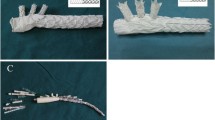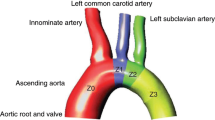Abstracts
Banding of the ascending aorta has been introduced as a less complex procedure to optimize the proximal landing zone of the stent graft in hybrid aortic arch surgery. However, data about the long-term results and effects of this technique are still limited. We aimed to study the efficacy of banding of the ascending aorta in hybrid aortic arch repair. The study included 11 high-risk patients with dilated ascending aorta (wider than 38 mm in diameter) undergoing ascending aortic banding for hybrid arch repair. Clinical outcomes, including technical success, endoleaks, perioperative mortality and morbidity, and sequential remodeling of the ascending aorta were investigated. The average diameter of the ascending aorta had been reduced (p = 0.02) from 42.1 mm (range = 39.0–46.4) to 37.2 mm (range = 35.6–38.6) after banding procedure. The technical success rate was 100.0%. No type I endoleak occurred, but 2 cases of distal stent graft-induced new entry required re-interventions. The 5-year survival and freedom from aortic events rates both were 81.8%. The ascending aortic diameter remained stable and no proximal migration of the stent graft was observed during the study period. The 5-year results validated the durability of this therapeutic modality, especially in high-risk patients.



Similar content being viewed by others
References
Weigang E, Parker J, Czerny M, Peivandi AA, Dorweiler B, Beyersdorf F, Siegenthaler MP (2009) Endovascular aortic arch repair after aortic arch de-branching. Ann Thorac Surg 87:603–607
Bavaria J, Milewski RK, Baker J, Moeller P, Szeto W, Pochettino A (2010) Classic hybrid evolving approach to distal arch aneurysms: toward the zone zero solution. J Thorac Cardiovasc Surg 140:S77–S80 (discussion S86–S91)
Bavaria J, Vallabhajosyula P, Moeller P, Szeto W, Desai N, Pochettino A (2013) Hybrid approaches in the treatment of aortic arch aneurysms: postoperative and midterm outcomes. J Thorac Cardiovasc Surg 145:S85–S90
Kanaoka Y, Ohki T, Maeda K, Baba T (2017) Analysis of risk factors for early type I endoleaks after thoracic endovascular aneurysm repair. J Endovasc Ther 24:89–96
Williams JB, Andersen ND, Bhattacharya SD, Scheer E, Piccini JP, McCann RL, Hughes GC (2012) Retrograde ascending aortic dissection as an early complication of thoracic endovascular aortic repair. J Vasc Surg 55:1255–1262
Antona C, Vanelli P, Petullà M, Gelpi G, Danna P, Lemma M, Inglese L (2007) Hybrid technique for total arch repair: aortic neck reshaping for endovascular-graft fixation. Ann Thorac Surg 83:1158–1161
Uchida N, Katayama K, Takahashi S, Sueda T (2013) Total arch repair using supra-aortic debranching technique with banding of the ascending aorta for endovascular stent graft fixation. Ann Vasc Surg 27:354.e5–354.e8
Gelpi G, Vanelli P, Mangini A, Danna P, Contino M, Antona C (2010) Hybrid aortic arch repair procedure: reinforcement of the aorta for a safe and durable landing zone. Eur J Vasc Endovasc Surg 40:709–714
Chen IM, Wu FY, Shih CC (2008) Banding technique for endovascular repair of arch aneurysm with unsuitable proximal landing zone. Circ J 72:1981–1985
Pecoraro F, Shingaki M, Steuer J, Chaykovska L, Rancic Z, Weber A, Nguyen-Kim TD, Bettex D, Veith FJ, Lachat M (2016) Treatment of isolated ascending aortic aneurysm by off-pump epiaortic wrapping is safe and durable. Interact Cardiovasc Thorac Surg 23:286–291
Dumfarth J, Michel M, Schmidli J, Sodeck G, Ehrlich M, Grimm M, Carrel T, Czerny M (2011) Mechanisms of failure and outcome of secondary surgical interventions after thoracic endovascular aortic repair (TEVAR). Ann Thorac Surg 91:1141–1146
Gottardi R, Funovics M, Eggers N, Hirner A, Dorfmeister M, Holfeld J, Zimpfer D, Schoder M, Donas K, Weigang E, Lammer J, Grimm M, Czerny M (2008) Supra-aortic transposition for combined vascular and endovascular repair of aortic arch pathology. Ann Thorac Surg 86:1524–1529
van Prehn J, Schlösser FJ, Muhs BE, Verhagen HJ, Moll FL, van Herwaarden JA (2009) Oversizing of aortic stent grafts for abdominal aneurysm repair: a systematic review of the benefits and risks. Eur J Vasc Endovasc Surg 38:42–53
Buijs RV, Zeebregts CJ, Willems TP, Vainas T, Tielliu IF (2016) Endograft sizing for endovascular aortic repair and incidence of endoleak type 1A. PLoS One 11:e0158042
Iba Y, Minatoya K, Matsuda H, Sasaki H, Tanaka H, Oda T, Kobayashi J (2014) How should aortic arch aneurysms be treated in the endovascular aortic repair era? A risk-adjusted comparison between open and hybrid arch repair using propensity score-matching analysis. Eur J Cardiothorac Surg 46:32–39
Tokuda Y, Oshima H, Narita Y, Abe T, Araki Y, Mutsuga M, Fujimoto K, Terazawa S, Yagami K, Ito H, Yamamoto K, Komori K, Usui A (2016) Hybrid versus open repair of aortic arch aneurysms: comparison of postoperative and mid-term outcomes with a propensity score-matching analysis. Eur J Cardiothorac Surg 49:149–156
Miao L, Song L, Sun SK, Wang ZG (2017) Meta-analysis of open surgical repair versus hybrid arch repair for aortic arch aneurysm. Interact Cardiovasc Thorac Surg 24:34–40
Shirakawa Y, Kuratani T, Shimamura K, Torikai K, Sakamoto T, Shijo T, Sawa Y (2014) The efficacy and short-term results of hybrid thoracic endovascular repair into the ascending aorta for aortic arch pathologies. Eur J Cardiothorac Surg 45:298–304 (discussion 304)
Czerny M, Weigang E, Sodeck G, Schmidli J, Antona C, Gelpi G, Friess T, Klocker J, Szeto WY, Moeller P, Pochettino A, Bavaria JE (2012) Targeting landing zone 0 by total arch rerouting and TEVAR: midterm results of a transcontinental registry. Ann Thorac Surg 94:84–89
Kotelis D, Geisbüsch P, Attigah N, Hinz U, Hyhlik-Dürr A, Böckler D (2011) Total vs hemi-aortic arch transposition for hybrid aortic arch repair. J Vasc Surg 54:1182–1186.e2
Andrási TB, Grossmann M, Zenker D, Danner BC, Schöndube FA (2017) Supra-aortic interventions for endovascular exclusion of the entire aortic arch. J Vasc Surg 66:281–297.e2
Canaud L, Ozdemir BA, Patterson BO, Holt PJ, Loftus IM, Thompson MM (2014) Retrograde aortic dissection after thoracic endovascular aortic repair. Ann Surg 260:389–395
Chen Y, Zhang S, Liu L, Lu Q, Zhang T, Jing Z (2017) Retrograde type A aortic dissection after thoracic endovascular aortic repair: a systematic review and meta-analysis. J Am Heart Assoc 6:e004649
Pecoraro F, Lachat M, Hofmann M, Cayne NS, Chaykovska L, Rancic Z, Puippe G, Pfammatter T, Mangialardi N, Veith FJ, Bettex D, Maisano F, Neff TA (2017) Mid-term results of zone 0 thoracic endovascular aneurysm repair after ascending aorta wrapping and supra-aortic debranching in high-risk patients. Interact Cardiovasc Thorac Surg 24:882–889
Bürk J, Blanke P, Stankovic Z, Barker A, Russe M, Geiger J, Frydrychowicz A, Langer M, Markl M (2012) Evaluation of 3D blood flow patterns and wall shear stress in the normal and dilated thoracic aorta using flow-sensitive 4D CMR. J Cardiovasc Magn Reson 14:84
Numata S, Itatani K, Kanda K, Doi K, Yamazaki S, Morimoto K, Manabe K, Ikemoto K, Yaku H (2016) Blood flow analysis of the aortic arch using computational fluid dynamics. Eur J Cardiothorac Surg 49:1578–1585
Gandet T, Canaud L, Ozdemir BA, Ziza V, Demaria R, Albat B, Alric P (2015) Factors favoring retrograde aortic dissection after endovascular aortic arch repair. J Thorac Cardiovasc Surg 150:136–142
Plonek T, Rylski B, Dumanski A, Siedlaczek P, Kustrzycki W (2015) Biomechanical analysis of wrapping of the moderately dilated ascending aorta. J Cardiothorac Surg 10:106
Plonek T (2014) A meta analysis and systematic review of wrapping of the ascending aorta. J Card Surg 29:809–815
Choi MS, Jeong DS, Lee HY, Sung K, Kim WS, Lee YT, Park PW (2015) Aortic wrapping for a dilated ascending aorta in bicuspid aortic stenosis. Circ J 79:778–784
Demondion P, Ramadan R, Azmoun A, Raoux F, Angel C, Nottin R, Deleuze P (2014) Aortic wrapping for stanford type A acute aortic dissection: short and midterm outcome. Ann Thorac Surg 97:1590–1596
Cohen O, Odim J, De la Zerda D, Ukatu C, Vyas R, Vyas N, Palatnik K, Laks H (2007) Long-term experience of girdling the ascending aorta with Dacron mesh as definitive treatment for aneurysmal dilation. Ann Thorac Surg 83:S780–S784 (discussion S785–S790)
Bauer M, Grauhan O, Hetzer R (2003) Dislocated wrap after previous reduction aortoplasty causes erosion of the ascending aorta. Ann Thorac Surg 75:583–584
Doyle M, Peeceeyan S, Bonar F, Horton M (2014) Rarefaction of the aorta under Dacron wrap: a rare complication. Interact Cardiovasc Thorac Surg 19:341–343
Gonzalez-Santos JM, Arnaiz-Garcia ME (2017) Wrapping of the ascending aorta revisited-is there any role left for conservative treatment of ascending aortic aneurysm? J Thorac Dis 9:S488–S497
Di Eusanio M, Berretta P, Cefarelli M, Castrovinci S, Folesani G, Alfonsi J, Pantaleo A, Murana G, Di Bartolomeo R (2015) Long-term outcomes after aortic arch surgery: results of a study involving 623 patients. Eur J Cardiothorac Surg 48:483–490
Hiratzka LF, Bakris GL, Beckman JA, Bersin RM, Carr VF, Casey DE Jr, Eagle KA, Hermann LK, Isselbacher EM, Kazerooni EA, Kouchoukos NT, Lytle BW, Milewicz DM, Reich DL, Sen S, Shinn JA, Svensson LG, Williams DM, American College of Cardiology Foundation/American Heart Association Task Force on Practice Guidelines, American Association for Thoracic Surgery, American College of Radiology; American Stroke Association; Society of Cardiovascular Anesthesiologists, Society for Cardiovascular Angiography and Interventions, Society of Interventional Radiology, Society of Thoracic Surgeons, Society for Vascular Medicine (2010) 2010 ACCF/AHA/AATS/ACR/ASA/SCA/SCAI/SIR/STS/SVM Guidelines for the diagnosis and management of patients with thoracic aortic disease. A Report of the American College of Cardiology Foundation/American Heart Association Task Force on Practice Guidelines, American Association for Thoracic Surgery, American College of Radiology, American Stroke Association, Society of Cardiovascular Anesthesiologists, Society for Cardiovascular Angiography and Interventions, Society of Interventional Radiology, Society of Thoracic Surgeons, and Society for Vascular Medicine. J Am Coll Cardiol 55:e27–e129
Acknowledgements
This work was supported by grants from the National Science Council, Taiwan (NSC98-2314-B-010-035-MY3, NSC101-2314-B-010-065-MY3, MOST105-2314-B-010-048-MY3, MOST 106-2314-B-101-056), and Taipei Veterans General Hospital, Taiwan (VGH-103E1-008, VGH-102C-137, VGH-103C-136, VGH-104-C-117, VGH-107C-147, VGH- V105D18-001-MY3-3). The authors thank Chun-Han Shih and Chun-Kai Shih for providing technical assistance.
Author information
Authors and Affiliations
Corresponding author
Ethics declarations
Conflict of interest
The authors declare that they have no conflict of interest.
Additional information
Publisher's Note
Springer Nature remains neutral with regard to jurisdictional claims in published maps and institutional affiliations.
Rights and permissions
About this article
Cite this article
Hsu, HL., Huang, CY., Chen, PL. et al. Efficacy of ascending aortic banding technique concomitant with type I hybrid aortic arch repair in high-risk patients. Heart Vessels 34, 1524–1532 (2019). https://doi.org/10.1007/s00380-019-01384-3
Received:
Accepted:
Published:
Issue Date:
DOI: https://doi.org/10.1007/s00380-019-01384-3




